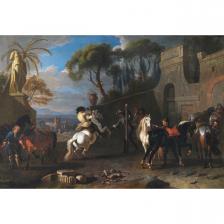Equestrian scene
The subject
The equestrian scene was one of the artist’s most loved themes. This figurative representation depicts a horseback riding school near some Roman ruins. Standaart, who began experimenting with genre painting first in his native Antwerp and then during his travels in France and Italy, where he remained at length, gained the favour of collectors by concentrating primarily on equestrian themes. In fact, one of his distinctive elements would become the white horse that appears at the centre of many of his works.
The painting
Pieter Van Bloemen was one of the artists working in the first half of the 18th century who embraced the concept of the rural Italian countryside interpreted as a new idyllic Arcadia. The theme of travel in the Italian peninsula (from the 18th century onwards) was broached with greater detachment, with a spirit of exploration rather than participation. From these observations came the vaguely literary image of a rural countryside that, though backward, was carefree and sunny. The Italian landscape was thus established as one of the most frequent subjects in the European art market, so much so as to be practically considered its own genre: based on the stylistic elements of the “idyllic countryside” in the Emilian or French schools of the 17th century, this genre would grow successfully until the 19th century.
Standaart worked in the transitional period leading up to this development. His was a style of painting that in some pieces displayed the influence of the ‘bamboccianti’, though never their genuine spontaneity. He developed his own language that distinguished him from others, finding it in an expert blend of pastoral landscape elements and his greatest passion: military and equestrian subjects. This painting is an important example: the tranquillity of a rural scene in the shade of ancient ruins is interrupted by the dynamism of a white steed that rears up pawing the ground, capturing the attention of the viewer and bringing to mind the composition of his first works as a young artist, when, as an apprentice in the workshop of the ‘battle painter’, Simon van Douw, in Antwerp, he painted horses as they were spurred on.







